
A single-lens reflex camera (SLR) is a camera that typically uses a mirror and prism system that permits the photographer to view through the lens and see exactly what will be captured. With twin lens reflex and rangefinder cameras, the viewed image could be significantly different from the final image. When the shutter button is pressed on most SLRs, the mirror flips out of the light path, allowing light to pass through to the light receptor and the image to be captured.
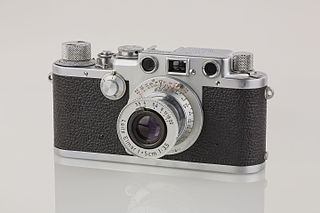
A camera is an optical instrument that captures images. Most cameras can capture 2D images, while some more advanced models can capture 3D images. At a basic level, most cameras consist of a sealed box, with a small hole that allows light to pass through and capture an image on a light-sensitive surface. Cameras have various mechanisms to control how light falls onto the light-sensitive surface, including lenses that focus the light and a shutter that determines the amount of time the photosensitive surface is exposed to the light.

A view camera is a large-format camera in which the lens forms an inverted image on a ground-glass screen directly at the film plane. The image is viewed and then the glass screen is replaced with the film, and thus the film is exposed to exactly the same image as was seen on the screen.

A twin-lens reflex camera (TLR) is a type of camera with two objective lenses of the same focal length. One of the lenses is the photographic objective or "taking lens", while the other is used for the viewfinder system, which is usually viewed from above at waist level.
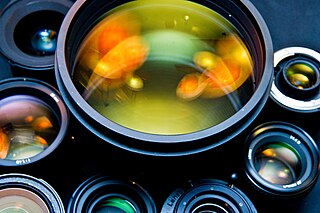
A camera lens is an optical lens or assembly of lenses used in conjunction with a camera body and mechanism to make images of objects either on photographic film or on other media capable of storing an image chemically or electronically.

A full-face diving mask is a type of diving mask that seals the whole of the diver's face from the water and contains a mouthpiece, demand valve or constant flow gas supply that provides the diver with breathing gas. The full face mask has several functions: it lets the diver see clearly underwater, it provides the diver's face with some protection from cold and polluted water and from stings, such as from jellyfish or coral. It increases breathing security and provides a space for equipment that lets the diver communicate with the surface support team.
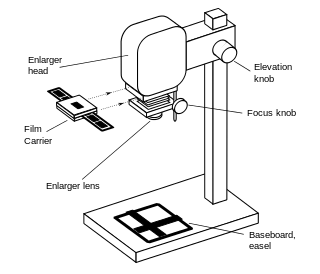
An enlarger is a specialized transparency projector used to produce photographic prints from film or glass negatives, or from transparencies.
In visual effects, match moving is a technique that allows the insertion of computer graphics into live-action footage with correct position, scale, orientation, and motion relative to the photographed objects in the shot. The term is used loosely to describe several different methods of extracting camera motion information from a motion picture. Sometimes referred to as motion tracking or camera solving, match moving is related to rotoscoping and photogrammetry. Match moving is sometimes confused with motion capture, which records the motion of objects, often human actors, rather than the camera. Typically, motion capture requires special cameras and sensors and a controlled environment. Match moving is also distinct from motion control photography, which uses mechanical hardware to execute multiple identical camera moves. Match moving, by contrast, is typically a software-based technology, applied after the fact to normal footage recorded in uncontrolled environments with an ordinary camera.

In photography, a lens hood or lens shade is a device used on the front end of a lens to block the Sun or other light source(s) to prevent glare and lens flare. Lens hoods may also be used to protect the lens from scratches and the elements without having to put on a lens cover.
The geometry of a lens hood is dependent on three parameters: the focal length of the lens, the size of the front lens element and the dimensions of the image sensor or film in the camera.
Mattes are used in photography and special effects filmmaking to combine two or more image elements into a single, final image. Usually, mattes are used to combine a foreground image with a background image. In this case, the matte is the background painting. In film and stage, mattes can be physically huge sections of painted canvas, portraying large scenic expanses of landscapes.
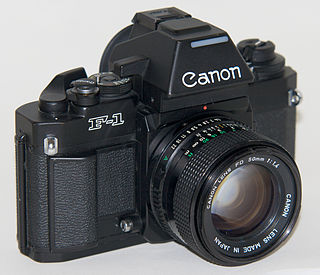
The Canon New F-1 replaced the F-1n as Canon's top-of-the-line 35mm single-lens reflex camera in 1981. Like the earlier models, the New F-1 takes FD-mount lenses. Although no date has ever been confirmed, it is thought that the last New F-1 was still being made in 1992. It was officially discontinued in 1994, and factory support ended in 2004.

Adobe Lightroom is a piece of image organization and image manipulation software developed by Adobe Inc. as part of the Creative Cloud subscription family. It is supported on Windows, macOS, iOS, Android, and tvOS. Its primary uses include importing, saving, viewing, organizing, tagging, editing, and sharing large numbers of digital images. Lightroom's editing functions include white balance, presence, tone, tone curve, HSL, color grading, detail, lens corrections, and calibration manipulation, as well as transformation, spot removal, red eye correction, graduated filters, radial filters, and adjustment brushing. The name of the software is based on darkrooms used for processing light-sensitive photographic materials.

The Mamiya C330 Professional is a traditional film twin-lens reflex camera introduced in the 1970s for the professional and advanced amateur photography markets. This model was 340 grams lighter than the previous model C33, which weighed 2040 grams. The later C330f is an improvement on the C330 and was succeeded by the C330S with further improvements.

The Nimslo is a stereo camera with a brightfield viewfinder that produces 3D pictures that can be viewed without glasses. This is done using lenticular printing. It uses common 35 mm film in 135 film format cartridges. It was produced in the 1980s by Nimstec of Atlanta, and manufactured by Timex in Dundee, Scotland.

The Mamiya RZ67 is a professional medium format single-lens reflex system camera manufactured by Mamiya. There are three successive models: the RZ67 Professional, RZ67 Professional II and RZ67 Professional IID. It is primarily designed for studio use, but can also be used in the field.
Stage lighting accessories are components manufactured for conventional (non-automated) stage lighting instruments. Most conventional fixtures are designed to accept a number of different accessories designed to assist in the modification of the output. These accessories are intended to either provide relatively common functionality not originally provided in a fixture, or to extend the versatility of a lighting instrument by introducing features. Other accessories have been designed to overcome limitations or difficulties some fixtures present in specific applications.
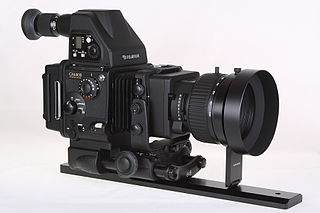
The Fuji GX680 is a series of single lens reflex system cameras for medium format film produced by Fujifilm with interchangeable camera lenses and interchangeable film holders for the unusual film format 6×8 cm on 120 and 220 roll film. The distinguishing feature of the Fuji GX680 is the articulating front standard, which runs on a rail connecting lens and camera body by a bellows; the interchangeable lens is permanently mounted to a lens board.

Plaubel is a German camera maker, founded in November, 1902, by Hugo Schrader, who learned the technology of cameras and lenses as an apprentice at Voigtländer in Braunschweig in the late 1800s before being employed by a Frankfurt camera and lens manufacturer and distributor, Dr. R. Krügener, whose daughter he married. Hugo Schrader and his wife elected to open their own business, Plaubel & Co., as distributors and makers of cameras and lenses, naming it after his brother-in-law because he thought Plaubel was easier to remember than Schrader.

The Kodak Cine Special 16mm Cameras (CKS) are a family of precision, versatile, spring-wound 16mm silent movie cameras produced by Eastman Kodak from the 1930s to the 1960s, and intended for advanced consumers and industry professionals. While its rectangular format was typical of earlier Kodak 16 mm cameras, the CKS 'box' was formed by two joined sections: the spring motor half with the user controls, winding cranks, and gear work to the shutter. The other half was a film magazine which docked to the motor. This allowed the cinematographer to pre-load multiple magazines of film for quick interchange of film.
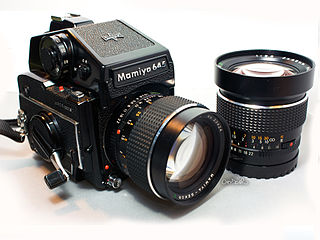
The Mamiya 645 camera systems are a series of medium format film and digital cameras and lenses manufactured by Mamiya and its successors. They are called "645" because they use the nominal 6 cm x 4.5 cm film size from 120 roll film. They came in three major generations: first-generation manual-focus film cameras, second-generation manual-focus film cameras, and autofocus film/digital cameras.


















